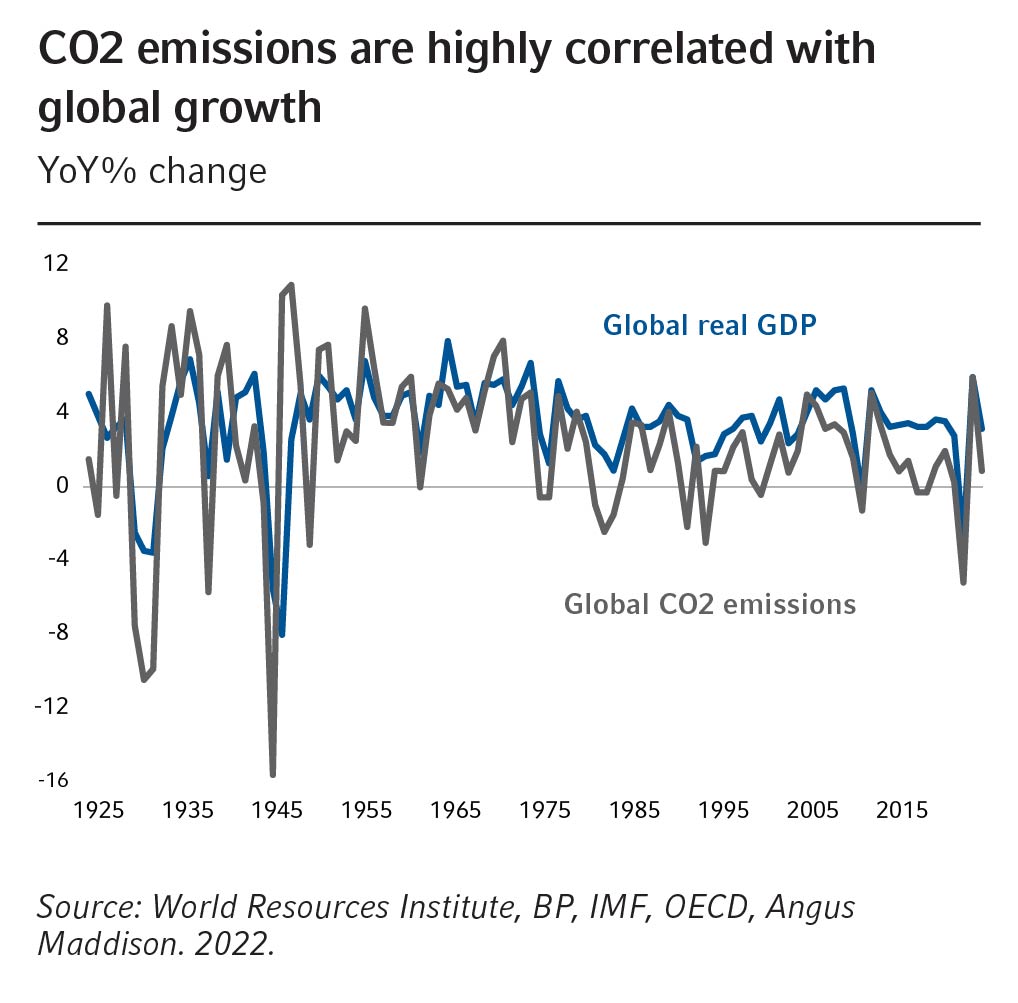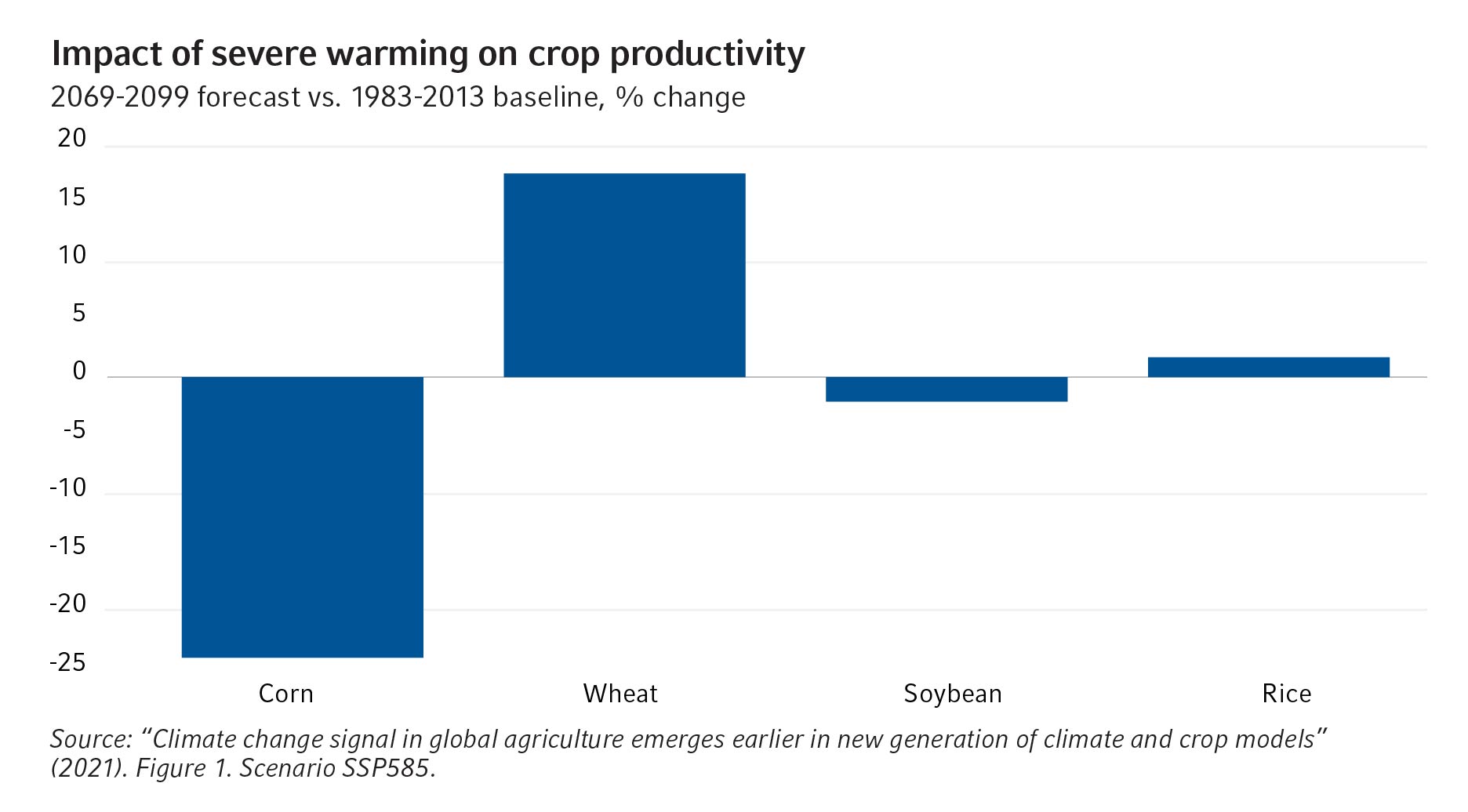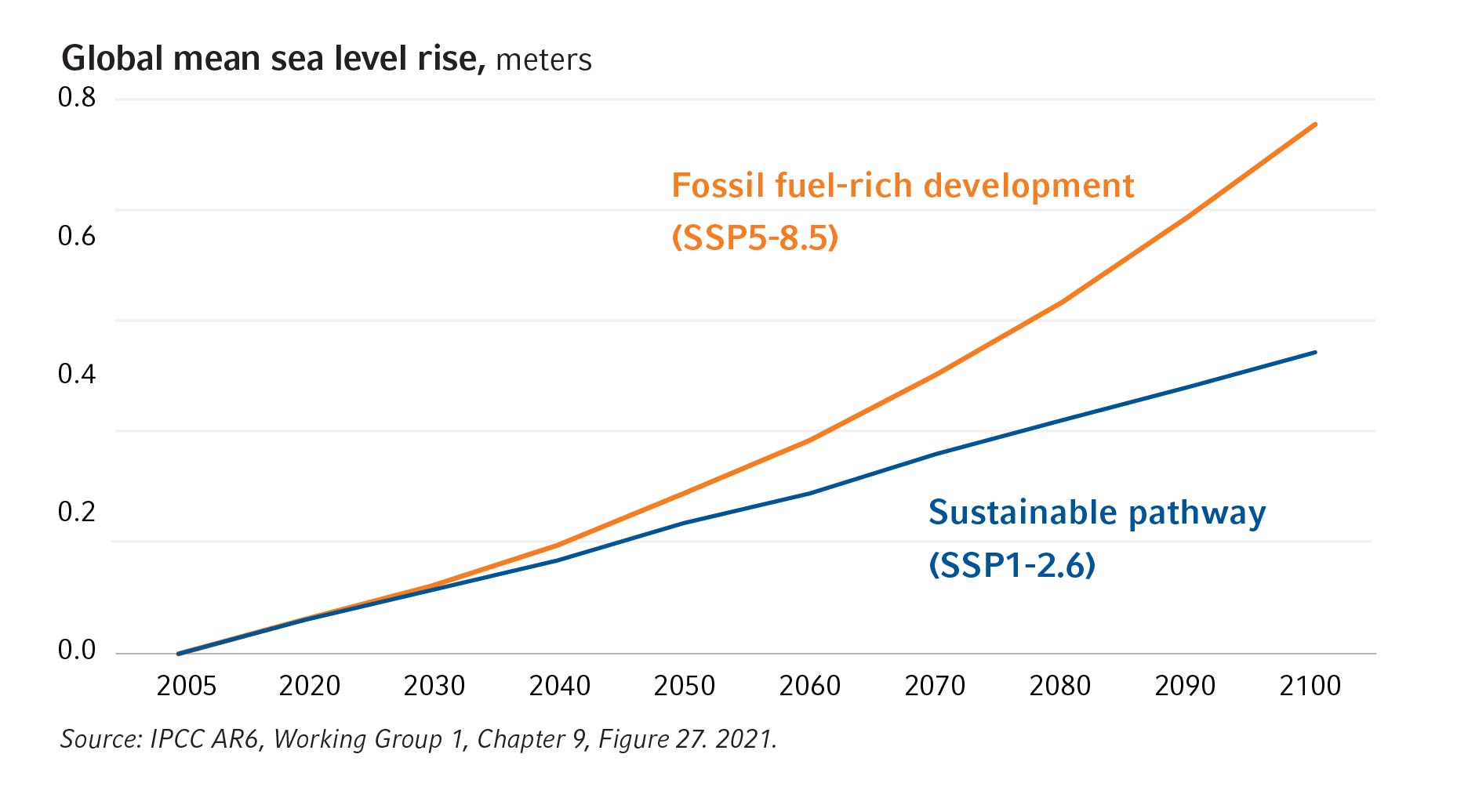by Paul Eitelman & Pierre Donga-Soria, Russell Investments
Executive summary:
- A transition away from fossil fuels is likely required to avert a significant warming of the planet.
- Rising temperatures could lead to crop failures, storm intensification, ocean acidification and deoxygenation, and infrastructure damage, among several other risks.
- Three key ways humans can deal with climate change are through mitigation, geoengineering and adaptation.
The world is transitioning towards a clean energy future, but the global economy is still overwhelmingly run on fossil fuels.
While we’re using far less carbon per unit of output than we did decades ago, those efficiency gains are not enough.
Hitting net zero in 2050 via efficiency gains alone would require global real GDP (gross domestic product) growth to average -1.5% for the next 37 years. That equates to a 2009 global financial crisis for 37 years in a row—a devastating scenario for living standards and our ability to invest, innovate, and adapt to this and future challenges.
A transition away from fossil fuels is likely required to avert a significant warming of the planet, but will be an enormous undertaking with undoubted implications for investments.
So, what can investors expect? Let’s start with a look at the potential damages to the economy if we fail to transition.
Damages from a warming planet
Greenhouse gases in the atmosphere trap heat near the Earth’s surface. The Intergovernmental Panel on Climate Change (IPCC) estimates temperatures on Earth could rise by 4.4°C/8°F by 2099 in an adverse emissions scenario.
Rising temperatures could have a number of effects:
Crop failure
Temperature, rainfall and other climate-related factors have an obvious impact on crop yields, which has implications for soft commodity markets. For example, hot temperatures can inhibit corn kernel growth, reducing yields. In contrast, wheat may benefit due to a broadening of cultivable land and a higher concentration of carbon dioxide in the atmosphere, which improves wheat’s photosynthesis and water retention.
Agriculture has a long history of adaptation—experimenting to increase crop yields and resilience to temperature extremes and drought. Such human interventions could help to mitigate some of the impacts of climate change.
Sea level rise
Global warming causes sea levels to rise due to melting land ice and thermal expansion. While this process is likely to be slow in the short-term, there are risks, such as storm surges leading to larger flood damages.
Looking further ahead, the IPCC’s severe warming scenario suggests water levels could rise by nearly a metre by 2100, and 3.5 metres by 2300—at which point many major port cities, such as Shanghai, Osaka, and Hong Kong—would regularly flood.
Adaptation to sea level rise is possible, but costly. Moving to higher ground is another, much more disruptive form of adaptation.
Biodiversity loss
Many species—from coral reefs to reptiles—will struggle to adapt to a rapidly warming planet.
Assigning an economic cost to species loss is challenging, and efforts have been made to build some resilience to species loss. The Millennium Seed Bank being a prominent example.
More significant effects could include damaged fisheries and a loss of pollinators, which may exacerbate global food security risks.
Storm intensification
Warmer air can hold more water vapor, increasing the risk of extreme rainfall events and causing tropical cyclones to become more intense—but also less frequent.
Storm intensification is likely to disrupt activity and raise the cost of doing business, with impacts on the availability and pricing of insurance and the all-in costs of owning property in coastal and other risk-prone areas.
Ocean acidification and deoxygenation
Mixing water with carbon dioxide forms carbonic acid, so as the ocean absorbs carbon dioxide, it will become more acidic. This will likely threaten food security through its impact on fisheries, particularly those for oysters, shellfish, plankton, and corals as carbonic acid dissolves calcium carbonate, which forms the shells of these marine organisms.
Ocean deoxygenation, which occurs due to warming, agricultural runoff, and other factors, can also be harmful to marine life.
Adverse impacts to human health
Extreme warming scenarios could eventually pose a threat to our survival as a species. Regions experiencing very high temperatures could become unlivable and face mass emigration.
Warmer temperatures can exacerbate existing cardiovascular disease, lead to malnutrition (due to food insecurity), and widen the range of latitudes exposed to tropical diseases.
While rising income levels in the developing world and increased access to advanced medical technology could offset many of these challenges, some studies suggest the adverse impacts to human health could be even larger than the economic costs from agriculture.
Damage to infrastructure
Warmer temperatures can decrease the transmission capacity of power lines by 2-6% in the summertime when demand is at peak levels. Concrete and asphalt can crack or buckle when exposed to wide variations in temperature. Drought conditions can disrupt green hydroelectric power generation and can disrupt thermoelectric power plants (nuclear, coal, gas, oil) where water is used in the cooling systems.
Interventions
There are several ways that humans can deal with climate change.
Mitigation includes all interventions that slow or reverse climate change by reducing greenhouse gas emissions. Mitigation strategies include:
- An energy transition—which is the focus of this work.
- Slowing the economy—although this is unrealistic given the scale of damage that would be required.
- Conserving energy—as Europe did recently in response to its energy crisis.
- Carbon capture and sequestration.
Mitigation is generally believed to be the safest solution from an environmental perspective, but it is also the costliest from an economic perspective.
Geoengineering involves changing the planet to counteract global warming. Geoengineering techniques include:
- Direct air capture (DAC) technologies which remove carbon dioxide from the atmosphere
- Installing large sunshades in outer space
- Painting large surfaces of the Earth white to improve reflectivity.
Geoengineering could be much cheaper than an energy transition, but the risk of a miscalculation could be catastrophic.
Adaptation includes strategies that help humans cope with and thrive on a warmer planet. Examples include:
- Air conditioning
- Modifying crops to survive in a changing climate
- Installing sea walls.
Importantly, adaptation does not cure the root-cause environmental problem. It simply reduces the impact on our lives and the global economy.
Our next article discusses the key challenges facing a transition away from carbon-based power. In the final article, we explore both a hot earth scenario and an energy transition scenario, including our observations for economies and markets.
For further details, read the complete report
Copyright © Russell Investments















